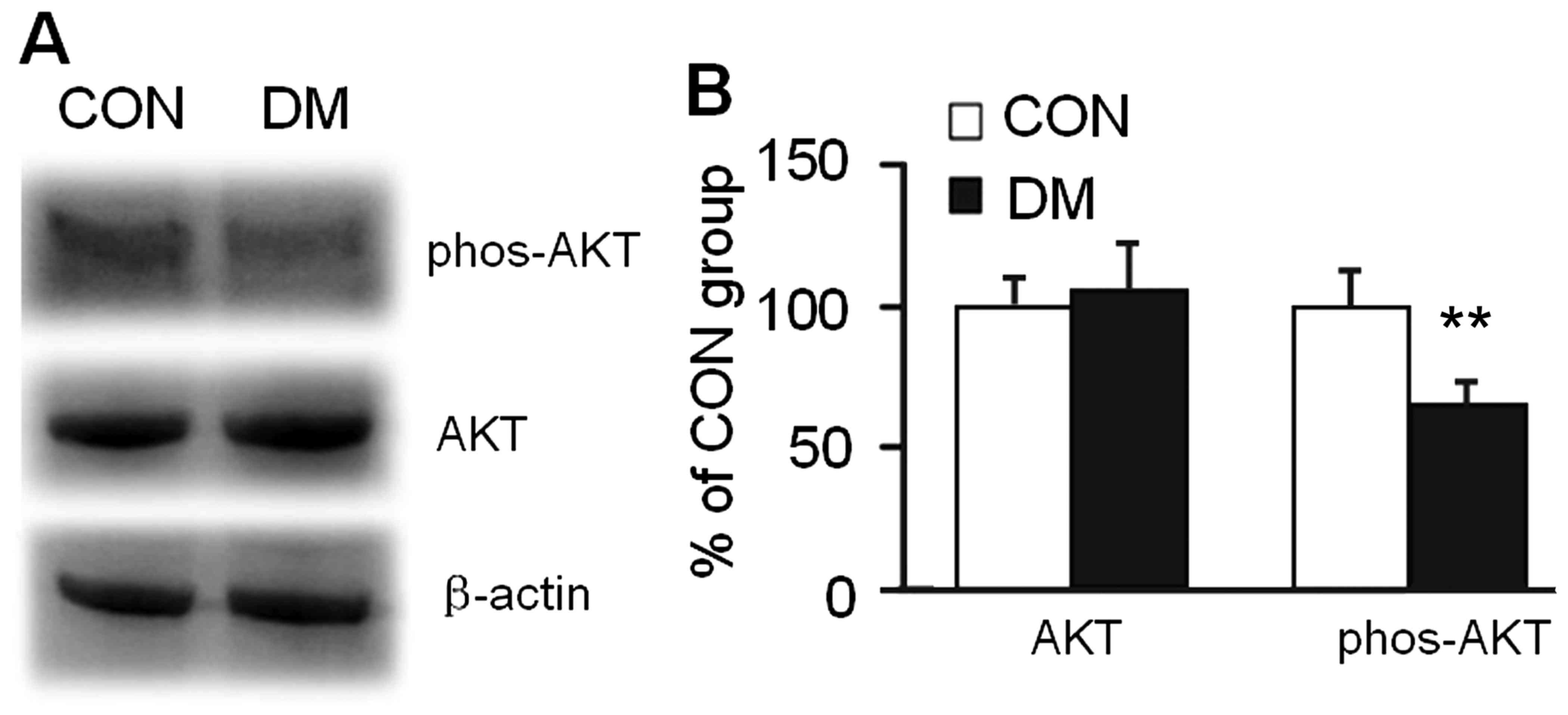|
1
|
Biessels GJ, van der Heide LP, Kamal A,
Bleys RL and Gispen WH: Ageing and diabetes: Implications for brain
function. Eur J Pharmacol. 441:1–14. 2002. View Article : Google Scholar : PubMed/NCBI
|
|
2
|
Reske-Nielsen E and Lundbaek K: Diabetic
encephalopathy diffuse and focal lesions of the brain in long-term
diabetes. Acta Neurol Scand Suppl. 39 Suppl4:S273–S290. 1963.
View Article : Google Scholar
|
|
3
|
Sima AA: Encephalopathies: The emerging
diabetic complications. Acta Diabetol. 47:279–293. 2010. View Article : Google Scholar : PubMed/NCBI
|
|
4
|
Mijnhout GS, Scheltens P, Diamant M,
Biessels GJ, Wessels AM, Simsek S, Snoek FJ and Heine RJ: Diabetic
encephalopathy: A concept in need of a definition. Diabetologia.
49:1447–1448. 2006. View Article : Google Scholar : PubMed/NCBI
|
|
5
|
Brands AM, Henselmans JM, de Haan EH and
Biessels GJ: Diabetic encephalopathy: An underexposed complication
of diabetes mellitus. Ned Tijdschr Geneeskd. 147:11–14. 2003.(In
Dutch). PubMed/NCBI
|
|
6
|
Perantie DC, Koller JM, Weaver PM, Lugar
HM, Black KJ, White NH and Hershey T: Prospectively determined
impact of type 1 diabetes on brain volume during development.
Diabetes. 60:3006–3014. 2011. View Article : Google Scholar : PubMed/NCBI
|
|
7
|
Kumar A, Haroon E, Darwin C, Pham D,
Ajilore O, Rodriguez G and Mintz J: Gray matter prefrontal changes
in type 2 diabetes detected using MRI. J Magn Reson Imaging.
27:14–19. 2008. View Article : Google Scholar : PubMed/NCBI
|
|
8
|
Korf ES, van Straaten EC, de Leeuw FE, van
der Flier WM, Barkhof F, Pantoni L, Basile AM, Inzitari D,
Erkinjuntti T, Wahlund LO, et al: Diabetes mellitus, hypertension
and medial temporal lobe atrophy: The LADIS study. Diabet Med.
24:166–171. 2007. View Article : Google Scholar : PubMed/NCBI
|
|
9
|
Liu JP, Feng L, Zhang MH, Ma DY, Wang SY,
Gu J, Fu Q, Qu R and Ma SP: Neuroprotective effect of liuwei
dihuang decoction on cognition deficits of diabetic encephalopathy
in streptozotocin-induced diabetic rat. J Ethnopharmacol.
150:371–381. 2013. View Article : Google Scholar : PubMed/NCBI
|
|
10
|
Liu J, Feng L, Ma D, Zhang M, Gu J, Wang
S, Fu Q, Song Y, Lan Z, Qu R and Ma S: Neuroprotective effect of
paeonol on cognition deficits of diabetic encephalopathy in
streptozotocin-induced diabetic rat. Neurosci Lett. 549:63–68.
2013. View Article : Google Scholar : PubMed/NCBI
|
|
11
|
Tsuchiya A, Kanno T and Nishizaki T: PI3
kinase directly phosphorylates Akt1/2 at Ser473/474 in the insulin
signal transduction pathway. J Endocrinol. 220:49–59. 2013.
View Article : Google Scholar : PubMed/NCBI
|
|
12
|
Sylow L, Kleinert M, Pehmøller C, Prats C,
Chiu TT, Klip A, Richter EA and Jensen TE: Akt and Rac1 signaling
are jointly required for insulin-stimulated glucose uptake in
skeletal muscle and downregulated in insulin resistance. Cell
Signal. 26:323–331. 2014. View Article : Google Scholar : PubMed/NCBI
|
|
13
|
Ji L, Zhang X, Liu W, Huang Q, Yang W, Fu
F, Ma H, Su H, Wang H, Wang J, et al: AMPK-regulated and
Akt-dependent enhancement of glucose uptake is essential in
ischemic preconditioning-alleviated reperfusion injury. PLoS One.
8:e699102013. View Article : Google Scholar : PubMed/NCBI
|
|
14
|
Leng Y, Wang Z, Tsai LK, Leeds P, Fessler
EB, Wang J and Chuang DM: FGF-21, a novel metabolic regulator, has
a robust neuroprotective role and is markedly elevated in neurons
by mood stabilizers. Mol Psychiatry. 20:215–223. 2015. View Article : Google Scholar : PubMed/NCBI
|
|
15
|
Ishikawa M, Yoshida K, Okamura H, Ochiai
K, Takamura H, Fujiwara N and Ozaki K: Oral porphyromonas
gingivalis translocates to the liver and regulates hepatic glycogen
synthesis through the Akt/GSK-3β signaling pathway. Biochim Biophys
Acta. 1832:2035–2043. 2013. View Article : Google Scholar : PubMed/NCBI
|
|
16
|
Kauffmann-Zeh A, Rodriguez-Viciana P,
Ulrich E, Gilbert C, Coffer P, Downward J and Evan G: Suppression
of c-Myc-induced apoptosis by ras signalling through PI(3)K and
PKB. Nature. 385:544–548. 1997. View
Article : Google Scholar : PubMed/NCBI
|
|
17
|
Khwaja A, Rodriguez-Viciana P, Wennström
S, Warne PH and Downward J: Matrix adhesion and ras transformation
both activate a phosphoinositide 3-OH kinase and protein kinase
B/Akt cellular survival pathway. EMBO J. 16:2783–2793. 1997.
View Article : Google Scholar : PubMed/NCBI
|
|
18
|
Zdychová J and Komers R: Emerging role of
AKT kinase/protein kinase B signaling in pathophysiology of
diabetes and its complications. Physiol Res. 54:1–16.
2005.PubMed/NCBI
|
|
19
|
Wang J, Yin H, Huang Y, Guo C, Xia C, Liu
Q and Zhang L: Panax quinquefolius saponin of stem and leaf
attenuates intermittent high glucose-induced oxidative stress
injury in cultured human umbilical vein endothelial cells via
PI3K/Akt/GSK-3 β pathway. Evid Based Complement Alternat Med.
2013:1962832013.PubMed/NCBI
|
|
20
|
Zhang W, Li R, Li J, Wang W, Tie R, Tian
F, Liang X, Xing W, He Y, Yu L, et al: Alpha-linolenic acid exerts
an endothelial protective effect against high glucose injury via
PI3K/Akt pathway. PLoS One. 8:e684892013. View Article : Google Scholar : PubMed/NCBI
|
|
21
|
Whittington HJ, Harding I, Stephenson CI,
Bell R, Hausenloy DJ, Mocanu MM and Yellon DM: Cardioprotection in
the aging, diabetic heart: The loss of protective Akt signalling.
Cardiovasc Res. 99:694–704. 2013. View Article : Google Scholar : PubMed/NCBI
|
|
22
|
Northam EA, Rankins D, Lin A, Wellard RM,
Pell GS, Finch SJ, Werther GA and Cameron FJ: Central nervous
system function in youth with type 1 diabetes 12 years after
disease onset. Diabetes Care. 32:445–450. 2009. View Article : Google Scholar : PubMed/NCBI
|
|
23
|
Perantie DC, Wu J, Koller JM, Lim A,
Warren SL, Black KJ, Sadler M, White NH and Hershey T: Regional
brain volume differences associated with hyperglycemia and severe
hypoglycemia in youth with type 1 diabetes. Diabetes Care.
30:2331–2337. 2007. View Article : Google Scholar : PubMed/NCBI
|
|
24
|
Ho MS, Weller NJ, Ives FJ, Carne CL,
Murray K, Driesen RI Vanden, Nguyen TP, Robins PD, Bulsara M, Davis
EA and Jones TW: Prevalence of structural central nervous system
abnormalities in early-onset type 1 diabetes mellitus. J Pediatr.
153:385–390. 2008. View Article : Google Scholar : PubMed/NCBI
|
|
25
|
Folli F, Guzzi V, Perego L, Coletta DK,
Finzi G, Placidi C, La Rosa S, Capella C, Socci C, Lauro D, et al:
Proteomics reveals novel oxidative and glycolytic mechanisms in
type 1 diabetic patients' skin which are normalized by
kidney-pancreas transplantation. PLoS One. 5:e99232010. View Article : Google Scholar : PubMed/NCBI
|
|
26
|
Rask-Madsen C and King GL: Mechanisms of
disease: Endothelial dysfunction in insulin resistance and
diabetes. Nat Clin Pract Endocrinol Metab. 3:46–56. 2007.
View Article : Google Scholar : PubMed/NCBI
|
|
27
|
Cheng XL and Li MK: Effect of topiramate
on apoptosis-related protein expression of hippocampus in model
rats with Alzheimers disease. Eur Rev Med Pharmacol Sci.
18:761–768. 2014.PubMed/NCBI
|
|
28
|
Zhang LM, Jiang CX and Liu DW: Hydrogen
sulfide attenuates neuronal injury induced by vascular dementia via
inhibiting apoptosis in rats. Neurochem Res. 34:1984–1992. 2009.
View Article : Google Scholar : PubMed/NCBI
|
|
29
|
Altiparmak UE: Toxic optic neuropathies.
Curr Opin Ophthalmol. 24:534–539. 2013. View Article : Google Scholar : PubMed/NCBI
|
|
30
|
Sinha K, Das J, Pal PB and Sil PC:
Oxidative stress: The mitochondria-dependent and
mitochondria-independent pathways of apoptosis. Arch Toxicol.
87:1157–1180. 2013. View Article : Google Scholar : PubMed/NCBI
|
|
31
|
Topham CH and Taylor SS: Mitosis and
apoptosis: How is the balance set? Curr Opin Cell Biol. 25:780–785.
2013. View Article : Google Scholar : PubMed/NCBI
|
|
32
|
Shamas-Din A, Kale J, Leber B and Andrews
DW: Mechanisms of action of Bcl-2 family proteins. Cold Spring Harb
Perspect Biol. 5:a0087142013. View Article : Google Scholar : PubMed/NCBI
|
|
33
|
Srinivasan S and Avadhani NG: Cytochrome c
oxidase dysfunction in oxidative stress. Free Radic Biol Med.
53:1252–1263. 2012. View Article : Google Scholar : PubMed/NCBI
|
|
34
|
Kulikov AV, Shilov ES, Mufazalov IA,
Gogvadze V, Nedospasov SA and Zhivotovsky B: Cytochrome c: The
Achilles' heel in apoptosis. Cell Mol Life Sci. 69:1787–1797. 2012.
View Article : Google Scholar : PubMed/NCBI
|
|
35
|
Smith MA and Schnellmann RG: Calpains,
mitochondria and apoptosis. Cardiovasc Res. 96:32–37. 2012.
View Article : Google Scholar : PubMed/NCBI
|
|
36
|
Van De Water TR, Lallemend F, Eshraghi AA,
Ahsan S, He J, Guzman J, Polak M, Malgrange B, Lefebvre PP,
Staecker H and Balkany TJ: Caspases, the enemy within and their
role in oxidative stress-induced apoptosis of inner ear sensory
cells. Otol Neurotol. 25:627–632. 2004. View Article : Google Scholar : PubMed/NCBI
|
|
37
|
Anarkooli I Jafari, Sankian M, Ahmadpour
S, Varasteh AR and Haghir H: Evaluation of Bcl-2 family gene
expression and caspase-3 activity in hippocampus STZ-induced
diabetic rats. Exp Diabetes Res. 2008:6384672008.PubMed/NCBI
|
|
38
|
Guo YJ, Wang SH, Yuan Y, Li FF, Ye KP,
Huang Y, Xia WQ and Zhou Y: Vulnerability for apoptosis in the
hippocampal dentate gyrus of STZ-induced diabetic rats with
cognitive impairment. J Endocrinol Invest. 37:87–96. 2014.
View Article : Google Scholar : PubMed/NCBI
|
|
39
|
Peng C, Ma J, Gao X, Tian P, Li W and
Zhang L: High glucose induced oxidative stress and apoptosis in
cardiac microvascular endothelial cells are regulated by FoxO3a.
PLoS One. 8:e797392013. View Article : Google Scholar : PubMed/NCBI
|
|
40
|
Romashkova JA and Makarov SS: NF-kappaB is
a target of AKT in anti-apoptotic PDGF signalling. Nature.
401:86–90. 1999. View
Article : Google Scholar : PubMed/NCBI
|
|
41
|
Song G, Ouyang G and Bao S: The activation
of AKT/PKB signaling pathway and cell survival. J Cell Mol Med.
9:59–71. 2005. View Article : Google Scholar : PubMed/NCBI
|
|
42
|
Gibson EM, Henson ES, Haney N, Villanueva
J and Gibson SB: Epidermal growth factor protects
epithelial-derived cells from tumor necrosis factor-related
apoptosis-inducing ligand-induced apoptosis by inhibiting
cytochrome c release. Cancer Res. 62:488–496. 2002.PubMed/NCBI
|
|
43
|
Kim EC, Yun BS, Ryoo IJ, Min JK, Won MH,
Lee KS, Kim YM, Yoo I and Kwon YG: Complestatin prevents apoptotic
cell death: Inhibition of a mitochondrial caspase pathway through
AKT/PKB activation. Biochem Biophys Res Commun. 313:193–204. 2004.
View Article : Google Scholar : PubMed/NCBI
|
|
44
|
Nakajima T, Iwabuchi S, Miyazaki H, Okuma
Y, Kuwabara M, Nomura Y and Kawahara K: Preconditioning prevents
ischemia-induced neuronal death through persistent Akt activation
in the penumbra region of the rat brain. J Vet Med Sci. 66:521–527.
2004. View Article : Google Scholar : PubMed/NCBI
|
|
45
|
Ren G, Kong J, Jia N and Shang X: Luteolin
attenuates neuronal apoptosis in the hippocampi of diabetic
encephalopathy rats. Neural Regen Res. 8:1071–1080. 2013.PubMed/NCBI
|


















